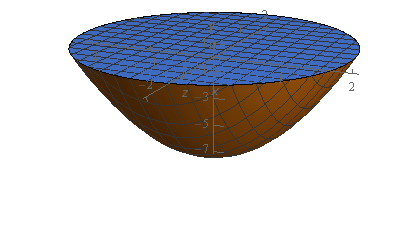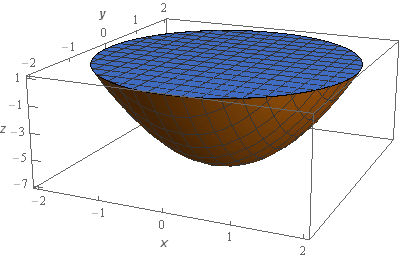Section 15.6 : Triple Integrals in Cylindrical Coordinates
1. Evaluate \(\displaystyle \iiint\limits_{E}{{4xy\,dV}}\) where \(E\) is the region bounded by \(z = 2{x^2} + 2{y^2} - 7\) and \(z = 1\).
Show All Steps Hide All Steps
Start SolutionOkay, let’s start off with a quick sketch of the region \(E\) so we can get a feel for what we’re dealing with.


We’ve given the sketches with a set of “traditional” axes as well as a set of “box” axes to help visualize the surface and region.
Show Step 2So, from the sketch above it should be pretty clear that we’ll need to integrate \(z\) first and so we’ll have the following limits for \(z\).
\[2{x^2} + 2{y^2} - 7 \le z \le 1\] Show Step 3For this problem \(D\) is the disk that “caps” the region sketched in Step 1. We can determine the equation of the disk by setting the two equations from the problem statement equal and doing a little rewriting.
\[2{x^2} + 2{y^2} - 7 = 1\hspace{0.25in} \to \hspace{0.25in}2{x^2} + 2{y^2} = 8\hspace{0.25in} \to \hspace{0.25in}{x^2} + {y^2} = 4\]So, \(D\) is the disk \({x^2} + {y^2} \le 4\) and it should be pretty clear that we’ll need to use cylindrical coordinates for this integral.
Here are the cylindrical coordinates for this problem.
\[\begin{array}{c}0 \le \theta \le 2\pi \\ 0 \le r \le 2\\ 2{r^2} - 7 \le z \le 1\end{array}\]Don’t forget to convert the \(z\) limits from Step 2 into cylindrical coordinates as well.
Show Step 4Plugging these limits into the integral and converting to cylindrical coordinates gives,
\[\begin{align*}\iiint\limits_{E}{{4xy\,dV}} & = \int_{0}^{{2\pi }}{{\int_{0}^{2}{{\int_{{2{r^2} - 7}}^{1}{{4\left( {r\cos \theta } \right)\left( {r\sin \theta } \right)r\,dz}}\,dr}}\,d\theta }}\\ & = \int_{0}^{{2\pi }}{{\int_{0}^{2}{{\int_{{2{r^2} - 7}}^{1}{{4{r^3}\cos \theta \sin \theta \,dz}}\,dr}}\,d\theta }}\end{align*}\]Don’t forget to convert the \(x\) and \(y\)’s into cylindrical coordinates and also don’t forget that \(dV = r\,dz\,dr\,d\theta \) and so we pick up another \(r\) when converting the \(dV\) to cylindrical coordinates.
Show Step 5Okay, now all we need to do is evaluate the integral. Here is the \(z\) integration.
\[\begin{align*}\iiint\limits_{E}{{4xy\,dV}} & = \int_{0}^{{2\pi }}{{\int_{0}^{2}{{\left. {\left( {4{r^3}\cos \theta \sin \theta z} \right)} \right|_{2{r^2} - 7}^1\,dr}}\,d\theta }}\\ & = \int_{0}^{{2\pi }}{{\int_{0}^{2}{{4{r^3}\left( {8 - 2{r^2}} \right)\cos \theta \sin \theta \,dr}}\,d\theta }}\\ & = \int_{0}^{{2\pi }}{{\int_{0}^{2}{{\left( {32{r^3} - 8{r^5}} \right)\cos \theta \sin \theta \,dr}}\,d\theta }}\end{align*}\] Show Step 6Next let’s do the \(r\) integration.
\[\begin{align*}\iiint\limits_{E}{{4xy\,dV}} & = \int_{0}^{{2\pi }}{{\left. {\left( {8{r^4} - \frac{4}{3}{r^6}} \right)\cos \theta \sin \theta } \right|_0^2\,d\theta }}\\ & = \int_{0}^{{2\pi }}{{\frac{{128}}{3}\cos \theta \sin \theta \,d\theta }}\end{align*}\] Show Step 7Finally, we’ll do the \(\theta \) integration.
\[\iiint\limits_{E}{{4xy\,dV}} = \int_{0}^{{2\pi }}{{\frac{{64}}{3}\sin \left( {2\theta } \right)\,d\theta }} = \left. { - \frac{{32}}{3}\cos \left( {2\theta } \right)} \right|_0^{2\pi } = \require{bbox} \bbox[2pt,border:1px solid black]{0}\]Note that we used the double angle formula for sine to simplify the integrand a little prior to the integration. We could also have done one of two substitutions for this step if we’d wanted to (and we’d get the same answer of course).